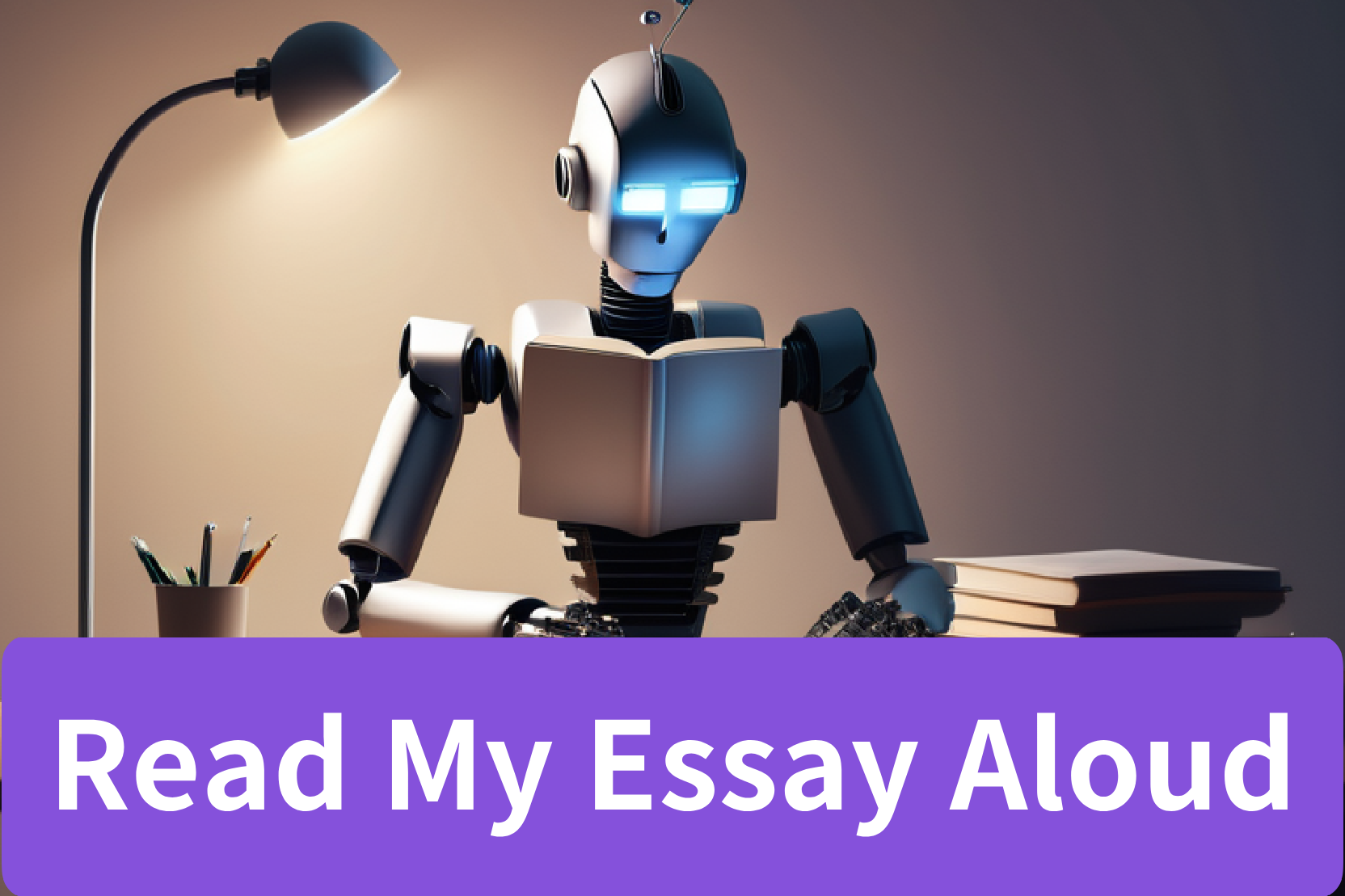Read my essay aloud: Elevating Educational Support with Text-to-Speech AI

Transform your writing process with our read my essay to me text-to-speech AI technology. Experience the difference now!
Key Highlights
- Text-to-speech AI employs sophisticated AI to transform text into natural-sounding, high-quality audio, enhancing comprehension and engagement.
- With a variety of voice options across languages and accents, TTS AI caters to diverse user preferences and needs and provides a cost-effective alternative to traditional voiceover methods, improving customization and accessibility for potential users.
- TTS AI enriches the learning experience by supporting multilingual education, enhancing comprehension and retention, and providing an inclusive learning approach for auditory learners.
Introduction
Text-to-speech AI has gained popularity in various fields, including essay writing, as it offers a unique way to engage with written content. In this blog, we will explore the world of text-to-speech AI and its key features, benefits, and practical applications.
Understanding Text-to-Speech Technology
Text-to-speech technology utilizes the power of artificial intelligence to convert written text into speech. The AI algorithms analyze the text, interpret its meaning, and generate a spoken output that closely resembles human speech. This technology provides users with an immersive and engaging auditory experience, enhancing their comprehension and retention of the content.
The quality of speech generated by text-to-speech AI has significantly improved over the years, with many tools offering customizable voices that sound natural and human-like. Users can choose from a variety of voices, including different accents and languages, to suit their preferences and needs.
Key features of Text-to-Speech AI
Customizable Voices and Languages
One of the key features of text-to-speech AI for essays is the ability to customize voices and languages. This feature is particularly beneficial for foreign language learners who want to improve their pronunciation and listening skills.
Text-to-speech AI tools offer a wide range of voices, including different accents and languages. Users can select the voice that best suits their needs and preferences, making the reading experience more enjoyable and immersive.
Reliability
Text-to-speech AI leverages advanced speech synthesis techniques that produce natural-sounding speech. This high-quality audio output is crucial for maintaining the listener’s interest and ensuring that the information is conveyed clearly and effectively. The natural flow and intonation of synthesized speech make the content more relatable and easier to understand, which promises high-quality and consistent audio output every time.
Cost-effective
Text-to-speech AI offers an economical solution for voiceovers, providing professional-quality results without the high costs associated with hiring voice actors or recording your own voice. This technology is an accessible and budget-friendly option for businesses and educators seeking to enhance their content with audio.

The Power of Text-to-Speech AI in Learning by Reading Essay Aloud
Text-to-speech AI has the power to transform learning by catering to different learning styles and enhancing the educational experience.
Support for Multilingual Education
TTS AI facilitates multilingual education with customizable voices across different languages, offering significant benefits to language learners seeking to improve their pronunciation and listening skills. By engaging with TTS AI, learners can practice listening in their target language, thereby enhancing their language proficiency.
Enhancing Comprehension and Retention
A key advantage of TTS AI is its ability to bolster comprehension and retention for auditory learners, who may struggle with traditional reading methods. The auditory presentation of text allows these learners to grasp nuances more effectively and has been shown to improve retention rates.
Accessibility for Users with Reading Difficulties
TTS AI provides a more accessible way for users with reading difficulties, such as dyslexia, to engage with written content. By converting text to speech, TTS AI offers an alternative learning approach that can significantly enrich the reading experience for those facing such challenges. By condensing the original content into its essential points, we maintain the core message while presenting it in a more concise and clear manner.

Advantages of Using Text-to-Speech AI for Educational Business
As TTS AI technology continues to evolve, its applications in the business sector are expanding. For example, educational support institutions can reap significant commercial benefits from TTS AI. By integrating TTS AI capabilities, they can offer more personalized and efficient educational services, reducing costs and enhancing productivity.
Enhancing Educational Experience
TTS AI injects interactivity into education, transforming text into engaging audio narratives that capture students’ interest and deepen their understanding of the subject matter. This technology facilitates a more dynamic learning process that is responsive to the varied needs of learners.
By integrating TTS AI into educational frameworks, institutions can offer personalized learning experiences. It supports auditory learners and those with reading difficulties, enhancing comprehension and retention, and enabling a more profound engagement with complex subjects.
Efficiency in Content Delivery
For educators, TTS AI offers a time-saving solution that streamlines content delivery. By converting written materials into audio, educators can quickly produce a range of learning resources. This efficiency allows educators to focus on other critical aspects of teaching and support, ultimately enhancing the overall quality of education provided by support institutions.

How Can I Produce a Commercial Text-to-Speech Tool Through TTS API in Novita AI?
To build a commercial TTS tool, research existing tools, define your target audience and features, design an intuitive interface, ensure high audio quality, and test rigorously. Consider scalability and user feedback for continuous improvement.
You can use the Text-to-Speech API to quickly produce such a tool. Using Novita AI Text to Speech API offers swift, expressive, and reliable voice synthesis. With real-time latency under 300ms, diverse voice styles, and seamless integration, it ensures high-quality, customizable audio for enhanced podcast user experiences.

Next, we’ll walk you through simple steps to help you understand.
- Step1. Understand Requirements: Clearly define the project’s goals, target audience, and features needed.
- Step2. Integrate API: Incorporate the Novita AI Text-to-Speech API into your backend system for voice synthesis.

- Step3. Develop User Interface: Create a user-friendly interface for inputting text and customizing voice settings.
- Step4. Implement Authentication: Ensure secure user authentication and authorization mechanisms.
- Step5. Test and Deploy: Thoroughly test the tool, deploy it to a production environment, and monitor its performance for continuous improvement.
How to Create Your First Text-to-Speech Demo?
Creating voiceovers using AI tools like Novita AI is a simple process. Follow these steps:
- Step 1: Head to the Novita AI website and create an account on it. navigate “text-to-speech” under the “Product” tab, you can test the effect first with the steps below.

- Step 2: Input the text that you want to get a voiceover about.
- Step 3: Select a voice model that you are interested in.

- Step 4: Click on the “Generate” button, and wait for it.
- Step 5: Once it is complete, you can preview it. If it fulfills your needs, you can download and apply the output.
Text-to-Speech AI Application Recommendations
To harness the full potential of Text-to-Speech technology in educational settings, consider the following recommended application:
Design Dynamic Classroom Activities
Educators can use the TTS technique to plan classroom activities, such as mock trials or historical reenactments, enhancing the interactivity and authenticity of learning through voice feedback.
Error Detection and Correction
Utilize TTS AI technology to convert written assignments into speech, assisting students in identifying and correcting grammatical errors, spelling mistakes, and disjointed sentence structures.
Content Consistency and Appeal Assessment
Writers and content creators should use TTS AI technology to listen to their work, assess the coherence and appeal of the content through auditory feedback, and make adjustments as needed to ensure their work resonates with the audience.
Conclusion
Text-to-speech AI is more than an assistive technology, it’s a catalyst for innovation across educational and professional landscapes. By making information accessible and engaging, it democratizes learning and empowers creators. As we venture further into the digital era, the integration of such AI tools is no longer a luxury but a necessity, ensuring that we can all keep pace with the rapidly evolving world of knowledge and communication.
Novita AI, the one-stop platform for limitless creativity that gives you access to 100+ APIs. From image generation and language processing to audio enhancement and video manipulation, cheap pay-as-you-go, it frees you from GPU maintenance hassles while building your own products. Try it for free.
Recommended reading